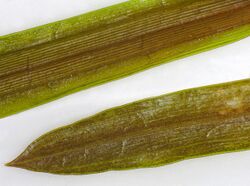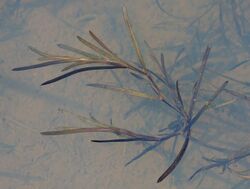Biology:Potamogeton acutifolius
| Potamogeton acutifolius | |
|---|---|

| |
| Potamogeton acutifolius (detail) | |
| Scientific classification | |
| Kingdom: | Plantae |
| Clade: | Tracheophytes |
| Clade: | Angiosperms |
| Clade: | Monocots |
| Order: | Alismatales |
| Family: | Potamogetonaceae |
| Genus: | Potamogeton |
| Species: | P. acutifolius
|
| Binomial name | |
| Potamogeton acutifolius Link, 1818
| |
| Synonyms[1] | |
| |
Potamogeton acutifolius is a European species of aquatic plant in the family Potamogetonaceae, known by the common name sharp-leaved pondweed.[2] It is threatened and declining in at least part of its range.
Description

Sharp-leaved pondweed grows annually from turions and seed, producing rather lax plants branching near the surface with strongly compressed stems and long, rather grass-like leaves that are 35–100 mm long and 1.5–5 mm wide and dark green, often with a marked reddish or brownish tinge.[3] Each leaf has one vein either side of the midrib. There are no rhizomes or floating leaves.
The inflorescences are up to 6 mm long with 4-6 flowers with a short peduncle (5–20 mm long, occasionally more).[3]
Within its range, sharp-leaved pondweed is relatively easily identified from all other pondweeds except the closely related grass-wrack pondweed (P. compressus) by its combination of strongly flattened stems, sclerenchymatous strands in the leaf (giving the submerged leaves an opaque appearance compared with the transparent appearance of other pondweeds) and leaves with sharply pointed (acute) tips.[3] Grass-wrack pondweed differs in having blunter tips to the leaves, leaves with 2 veins either side of the midrib, and infloresecences with 10–20 flowers on long peduncles, 28–95 mm long.[3]
Hybrids with P. berchtoldii (P. × sudermanicus Hagstr.) and P. friesii (P. × pseudofriesii Dandy & G.Taylor) have been recorded. Both are rare.[3] In northeast Europe, DNA evidence indicates that hybrids with P. compressus are fairly frequent, but often overlooked because of the difficulty of reliably identifying them.[4]
Taxonomy
Potamogeton acutifolius was described in 1815 by the German botanist Johann Link. The specific epithet, acutifolius, meaning "acute leaved", is derived from Latin acutus (pointed, acute), and -folius (-leaved), referring to the pointed leaf tips.[5]
Within the genus Potamogeton, Sharp-leaved pondweed is within the Section Graminifolii (fine-leaved pondweeds). It is closely related to P. compressus, P. zosterifolius and P. mandschuriensis,[6][7][8] all of which also have sclerenchymatous strands.
Distribution
Potamogeton acutifolius is native to Europe, including the UK, Czech Republic, Balkans[9] and Denmark.[10] In Britain it has always been rather rare and now has a very restricted distribution to suitable habitat in south-east England.
Ecology and conservation

In Britain, P. acutifolius is almost exclusively restricted to shallow, circumneutral, species-rich ditches on lowland grazing marshes,[3][11] often with fairly high conductivity.[12] Although there are some fairly strong populations remaining in Britain, these are vulnerable to changes in farming practice, pollution and sea level rise.[12] As ditch systems are an artificial habitat type, sharp-leaved pondweed presumably relied on a now destroyed habitat in Britain, a possible candidate being natural lowland river-floodplain wetland areas, which could create disturbed areas for this plant to exploit. Alternatively, it may have been associated with a now extinct species such as beaver.
Sharp-leaved pondweed has declined markedly in both Britain[11] and Denmark.[10] On the British[13] and Swiss[14] Red Lists for Vascular Plants it is listed as Critically Endangered and it is a UK Biodiversity Action Plan priority species.[15] It is classed as Vulnerable in the Czech Republic[16] and Germany.[17] In Flanders it is classed as Rare[18] and in the Netherlands it is Near Threatened.[19]
Cultivation
Potamogeton acutifolius is not in general cultivation, and its rarity suggests that it may be difficult to cultivate. It would need to be grown in rather silty, nutrient-rich ponds that are regularly cleaned out in order to suppress competing vegetation.
References
- ↑ Royal Botanic Gardens Kew and Missouri Botanic Gardens. The Plant List: Potamogeton acutifolius. Accessed 21 November 2014.
- ↑ (xls) BSBI List 2007, Botanical Society of Britain and Ireland, https://bsbi.org/download/3542/, retrieved 17 October 2014
- ↑ 3.0 3.1 3.2 3.3 3.4 3.5 Preston C.D. (1995). Pondweeds of Great Britain and Ireland. BSBI Handbook No. 8. Botanical Society of the British Isles, London.
- ↑ Zalewska-Galosz J., Ronikier M. 2010. Are linear-leaved Potamogeton hybrids really so rare? Molecular evidence for multiple hybridizations between P. acutifolius and P.compressus in Central Europe. Nordic Journal of Botany, 28, 257-261.
- ↑ Eggli, Urs; Newton, Leonard E. (2004). Etymological Dictionary of Succulent Plant Names. Berlin, Heidelberg: Springer. p. 2. ISBN 978-3-540-00489-9. https://books.google.com/books?id=u2n5vusQ1DEC&pg=PA2. Retrieved 19 November 2018.
- ↑ Wiegleb G., Kaplan Z. 1998. An account of the species of Potamogeton L. Folia Geobotanica, 33, 241-316.
- ↑ Kaplan Z., Marhold K. 2012. Multivariate morphometric analysis of the Potamogeton compressus group. Botanical Journal of the Linnean Society, 170, 112-130.
- ↑ Lindqvist C., De Laet J., Haynes R.R., Aagesen L., Keener B.R., Albert V.A. 2006. Molecular phylogenetics of an aquatic plant lineage, Potamogetonaceae. Cladistics, 22, 568-588.
- ↑ Talevska M., Petrovic D., Milosevic D., Talevski T., Maric D., Talevska A. 2009. Biodiversity of Macrophyte Vegetation from Lake Prespa, Lake Ohrid and Lake Skadar, Biotechnology & Biotechnological Equipment,23:sup1, 931-935, DOI:10.1080/13102818.2009.10818575
- ↑ 10.0 10.1 Sand-Jensen K, Riis T, Vestergaard O. Larsen S.E. 2000. Macrophyte decline in Danish lakes and streams over the past 100 years. Journal of Ecology, 88, 1030–1040.
- ↑ 11.0 11.1 Online Atlas of the British and Irish Flora
- ↑ 12.0 12.1 Newbold C. 2003. The ecology and status of sharp-leaved pondweed (Potamogeton acutifolius) in 2003. Report to English Nature No. EIT340107. English Nature, Peterborough.
- ↑ Cheffings C.M., Farrell, L. (Eds), Dines T.D., Jones R.A., Leach S.J., McKean D.R., Pearman D.A., Preston C.D., Rumsey F.J., Taylor I. 2005. The Vascular Plant Red Data List for Great Britain. Species Status, 7, 1-116. Joint Nature Conservation Committee, Peterborough.
- ↑ Moser D.M., Gygax A., Bäumler B., Wyler N., Palese R. 2002. Liste rouge des espèces menacées de Suisse. Fougères et plantes à fleurs. Ed. Office fédéral de l’environnement, des forêts et du paysage, Berne; Centre du Réseau Suisse de Floristique, Chambésy; Conservatoire et Jardin botaniques de la Ville de Genève, Chambésy. Série OFEFP «L’environnement pratique». 118 pp.
- ↑ Joint Nature Conservation Committee (JNCC). 2010. UK Priority Species Pages. Version 2. Potamogeton acutifolius.
- ↑ Grulich V. 2012. Red List of vascular plants of the Czech Republic: 3rd edition. Preslia, 84, 631–645.
- ↑ http://www.floraweb.de/pflanzenarten/artenhome.xsql?suchnr=4457& Bundesamt für Naturschutz: Potamogeton acutifolius (in German)
- ↑ Van Landuyt W., Vanhecke L., Hoste I. 2006. Rode Lijst van de vaatplanten van Vlaanderen en het Brussels Hoofdstedelijk Gewest. In : Van Landuyt W. et al. Atlas van de Flora van Vlaanderen en het Brussels Gewest. INBO en Nationale Plantentuin van België, Brussel. Web version.
- ↑ Sparrius L.B., Odé B., Beringen R. 2014. Basisreport Rode Lijst Vaatplanten 2012 volgens Nederlandse en IUCN-criteria. FLORON Rapport 57. Floron, Nijmegen.
Wikidata ☰ Q10906279 entry
 |

